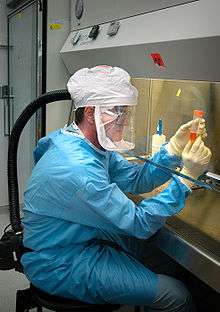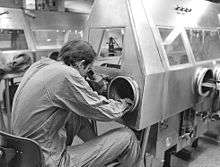Biosafety cabinet
 A microbiologist performing influenza research within a biosafety cabinet | |
| Acronym | BSC |
|---|---|
| Other names | Biological safety cabinet, microbiological safety cabinet |
| Uses | Biocontainment |
| Related items |
Laminar flow cabinet Fume hood Glove box |
A biosafety cabinet (BSC) — also called a biological safety cabinet or microbiological safety cabinet — is an enclosed, ventilated laboratory workspace for safely working with materials contaminated with (or potentially contaminated with) pathogens requiring a defined biosafety level. Several different types of BSC exist, differentiated by the degree of biocontainment required. BSCs first became commercially available in 1950.[1]
Purposes
The primary purpose of a BSC is to serve as a means to protect the laboratory worker and the surrounding environment from pathogens. All exhaust air is HEPA-filtered as it exits the biosafety cabinet, removing harmful bacteria and viruses.[2] This is in contrast to a laminar flow clean bench, which blows unfiltered exhaust air towards the user and is not safe for work with pathogenic agents.[3]:13[4] Neither are most BSCs safe for use as fume hoods.[2] Likewise, a fume hood fails to provide the environmental protection that HEPA filtration in a BSC would provide.[5] However, most classes of BSCs have a secondary purpose to maintain the sterility of materials inside (the "product").
Classes
The U.S. Centers for Disease Control and Prevention (CDC) classifies BSCs into three classes.[3]:6 These classes and the types of BSCs within them are distinguished in two ways: the level of personnel and environmental protection provided and the level of product protection provided.
Class I
Class I cabinets provide personnel and environmental protection but no product protection. In fact, the inward flow of air can contribute to contamination of samples.[6] Inward airflow is maintained at a minimum velocity of 75 ft/min(0.38 m/s). These BSCs are commonly used to enclose specific equipment (e.g. centrifuges) or procedures (e.g. aerating cultures) that potentially generate aerosols. BSCs of this class are either ducted (connected to the building exhaust system) or unducted (recirculating filtered exhaust back into the laboratory).[3]:6
Class II

Class II cabinets provide both kinds of protection (of the samples and of the environment) since makeup air is also HEPA-filtered. There are four types: Type A1 (formerly A), Type A2 (formerly A/B3), Type B1, and Type B2. Each type's requirements are defined by NSF International Standard 49,[3]:31 which in 2002 reclassified A/B3 cabinets (classified under the latter type if connected to an exhaust duct) as Type A2.[5] About 95% of all biosafety cabinets installed are Type A2 cabinets.[6]
The principle of operation involves using a fan mounted in the top of the cabinet to draw a curtain of sterile air over the products that are being handled. The air is then drawn underneath the work surface and back up to the top of the cabinet where it passes through the HEPA filters. The air that is exhausted is made up by air being drawn into the front of the cabinet underneath the work surface. The air being drawn in acts as a barrier to potentially contaminated air coming back out to the operator.
The Type A1 cabinet, formerly known as Type A, has a minimum inflow velocity of 75 ft/min. The filtered makeup air is divided equally over the work surface at about two to six inches above the work surface. Exhaust is drawn at the bottom of the cabinet where it rises to the top. At the top of the cabinet, 70% of the air recirculates through the supply HEPA filter, the other 30% of air exhausted through the exhaust HEPA filter.[5] This is due to the relative sizes of the two filters, and dampers typically allow the adjustment of this ratio. This type is not safe for work with hazardous chemicals except when ducted, usually with a "thimble" or canopy hood to avoid disturbing internal air flow.[3]:8–9
The Type A2 cabinet, formerly designated A/B3, has a minimum inflow velocity of 100 ft/min. A negative air pressure plenum surrounds all contaminated plenums that are under positive pressure. In other respects, the specifications are identical to those of a Type A1 cabinet.[3]:9–11[5]
The Type B1 and B2 cabinets have a minimum inflow velocity of 100 ft/min, and these cabinets must be hard-ducted to an exhaust system rather than exhausted through a thimble connection. In contrast to the type A1 and A2 cabinets, B1 cabinets split the airflow so 60% of air is exhausted and only 40% is recirculated, with the air collected through the rear grille being exhausted, and air through the front grille being recirculated.[5] Since exhaust air is drawn from the rear grille, the CDC advises that work with chemicals be conducted in the rear of the cabinet.[3]:10 The Type B2 cabinet is expensive to operate because no air is recirculated within.[3] Therefore, this type is mainly found in such applications as toxicology laboratories, where the ability to safely use hazardous chemicals is important.[5] Additionally, there is the risk that contaminated air would flow into the laboratory if the exhaust system for a Type B1 or B2 cabinet were to fail. To mitigate this risk, cabinets of these types generally monitor the exhaust flow, shutting off the supply blower and sounding an alarm if the exhaust flow is insufficient.[3]:10–11
Class II cabinets are the commonly used cabinets in clinical and research laboratories.
Class III


The Class III cabinet, generally only installed in maximum containment laboratories, is specifically designed for work with BSL-4 pathogenic agents, providing maximum protection. The enclosure is gas-tight, and all materials enter and leave through a dunk tank or double-door autoclave. Gloves attached to the front prevent direct contact with hazardous materials (Class III cabinets are sometimes called glove box). These custom-built cabinets often attach into a line, and the lab equipment installed inside is usually custom-built as well.[3]:12–13
Ergonomics
Biosafety cabinets are used on a daily basis for hours. Besides protection of user and sample material, the ergonomical aspects of the work become more and more important. This includes reduction of the noise level (for a more convenient working atmosphere), a height adjustable stand (for optimized sitting position), panorama side windows (more light within cabinet), 10°angled front sash (enables better sitting position) as well as strong but dazzle-free light sources (better view within cabinet) to improve the working conditions.
Ultraviolet lamps
The CDC does not recommend the installation of UV lamps in BSCs.[3]:12–13 The American Biological Safety Association supports this position, citing the safety risk to personnel, shallow penetration, reduced effectiveness in high relative humidity, and the frequent need to clean and replace the bulb.[7] However, these assertions have been formally disputed in at least one peer-reviewed article which points out that:[8]
- There is no cited basis for the need to remove dust and dirt from bulbs
- Properly functioning biosafety cabinets have very clean air so dust is less likely to build up
- Laboratories are generally air-conditioned which eliminates the concern over humidity inhibition of UV effectiveness
- With proper use UV exposure risk to users is very low
- UV disinfection is effective for germicide and virucide as well as inhibiting DNA contamination from PCR
- UV disinfection has the advantage of not leaving residues like physical disinfectants
- The relative safety and risks of UV versus other disinfection techniques (which also entail risks) should be considered
Maintenance and service
Cabinets need to be maintained on a regular schedule. During this check, the airflow and the filter capacities are controlled. The filters have a limited lifespan. Depending on the laboratory environment and the type of samples used, the filter air flow-through is reduced over time. Newer cabinets measure the air flow-through constantly. If the flow-through is too low, there will be an audial and visual alarm. Changing the filter should be limited to trained persons as the filter is potentially contaminated and a "bag-in/bag-out" procedure needs to be followed. When an UV light is used, this lamp should be checked and changed as well. UV lights decrease in power over time, resulting in suboptimal disinfection of the working area.
Work practices
As with work on open bench tops, work performed within a BSC must be performed carefully and safely. To avoid contamination and the risk of personnel exposure, the CDC advises investigators to follow best practices to reduce and control splatter and aerosol generation, such as keeping clean materials at least 12 inches (30 cm) from aerosol-generating activities and arranging the work flow "from clean to contaminated".[3]:22 In particular, open flames, not necessary within the clean environment of a Class II or III BSC, cause disruption of the airflow inside.[3]:22 Once work inside a BSC has been completed, it is necessary to decontaminate the surfaces of the BSC as with other lab equipment and materials.[3]:24
When a BSC is serviced or relocated, including replacement of HEPA filters, it must be gas decontaminated. Gas decontamination involves filling the BSC with a poisonous gas, most commonly formaldehyde gas.[3]:25
See also
| Wikimedia Commons has media related to Fume hoods. |
References
- ↑ Wedum, A.G. (1969), "The Detrick experience as a guide to the probable efficacy of P4 microbiological containment facilities for studies on microbial recombinant DNA molecules"; J Am Biol Safety Assoc;1:7-25.
- 1 2 Iowa State University (2005). "Biosafety Cabinets". Retrieved April 24, 2010.
- 1 2 3 4 5 6 7 8 9 10 11 12 13 14 15 U.S. Centers for Disease Control and Prevention; U.S. National Institutes of Health (2000). Primary Containment for Biohazards: Selection, Installation and Use of Biological Safety Cabinets (PDF). U.S. Centers for Disease Control and Prevention.
- ↑ University of Pennsylvania (November 6, 2009). "Clean Benches vs. Biosafety Cabinets". Retrieved April 24, 2010.
- 1 2 3 4 5 6 The Baker Company (2010). "Introduction to Biological Safety Cabinets". Retrieved April 26, 2010.
- 1 2 DePalma, Angelo (October 7, 2009). "Product Focus: Biological Safety Cabinets". Lab Manager. Retrieved April 26, 2010.
- ↑ American Biological Safety Association (December 2000). "Position Paper on the Use of Ultraviolet Lights in Biological Safety Cabinets" (PDF). Retrieved April 26, 2010.
- ↑ Meechan, Paul; Christina Wilson (2006). "Use of Ultraviolet Lights in Biological Safety Cabinets: A Contrarian View". Applied Biosafety 11 (4): 222–227.
| ||||||||||||||||||||||||||||||||||||||||||||||||||||||||||||||||||||||||||||||||||||||||||||||||||||||||||||||||||||||||||||||||||||||